Modernizing legacy systems isn't merely a technical upgrade—it’s a critical business transformation tactic that reduces costs, improves agility, and boosts productivity. For many enterprises in the US and Canadian markets, this is no longer optional.
This is precisely where a Legacy Modernization ROI Calculator becomes invaluable. It shifts the conversation from abstract technological necessity to quantifiable financial and operational impact. By accurately measuring the estimated return on investment, the calculator strengthens the business case for application modernization, helping organizations secure executive buy-in and make data-backed decisions.
In this comprehensive blog, we'll explore how using a legacy modernization ROI calculator simplifies financial planning, strengthens the case for transformation, and guides your organization to maximize ROI across all legacy modernization initiatives, from cloud migration to core application refactoring.
Understanding Legacy System ROI Analysis
A legacy system ROI analysis helps enterprises assess the return on investment gained after migrating, refactoring, or replatforming outdated software systems. It moves beyond simple cost comparisons to balance the comprehensive modernization costs against measurable, long-term benefits. These benefits, when quantified, form the basis of a compelling investment pitch.
The Hidden Costs of Inaction
Many organizations operate under the false assumption that their outdated systems are stable and cost-effective simply because they are paid for. This mindset drastically understates the actual financial burden. Legacy systems carry significant hidden costs, collectively known as legacy system technical debt.
These expenditures include:
- Skyrocketing Maintenance Costs: Specialized skills required to maintain decades-old codebases are increasingly scarce, driving up support and licensing costs. This is a primary driver of legacy system maintenance costs.
- Productivity Loss: Rigid, slow, and non-integrated systems force employees to resort to manual workarounds and inefficient processes, hindering productivity gains after modernization.
- Inability to Innovate: The monolithic structure of many legacy software systems prohibits the rapid deployment of new features (slowing down time-to-market), which is the cost of inaction in legacy systems.
- Security and Compliance Risk: Outdated software lacks modern security protocols, exposing the business to potentially catastrophic breaches and regulatory non-compliance fines.
A comprehensive ROI analysis for refactoring or replatforming must quantify these ongoing losses. By presenting the financial damage of standing still, you directly align modernization efforts with critical business outcomes, creating a robust business case for application modernization.
Typical Modernization Returns and Payback
Most successful modernization projects today are justified by aggressive ROI metrics, where companies typically expect significant returns. Based on industry data, organizations often target and achieve:
- 15–25% returns on their total modernization investment.
- A payback period of approximately 2 to 3 years for modernization.
A dedicated legacy modernization ROI calculator is the tool that transforms these aspirational targets into concrete financial projections.
Why a Legacy Modernization ROI Calculator Matters
A legacy modernization ROI calculator provides a measurable, structured framework for ROI measurement in modernization initiatives. It transforms vague goals like "improving performance" into concrete financial benefits, such as "reducing support ticket volume by 40%," which translates into specific dollar savings.
The calculator is designed to eliminate guesswork by integrating cost, performance, and productivity data into a unified decision model.
Key Assessment Areas
An effective calculator provides a holistic view of the financial landscape by assessing four critical areas:
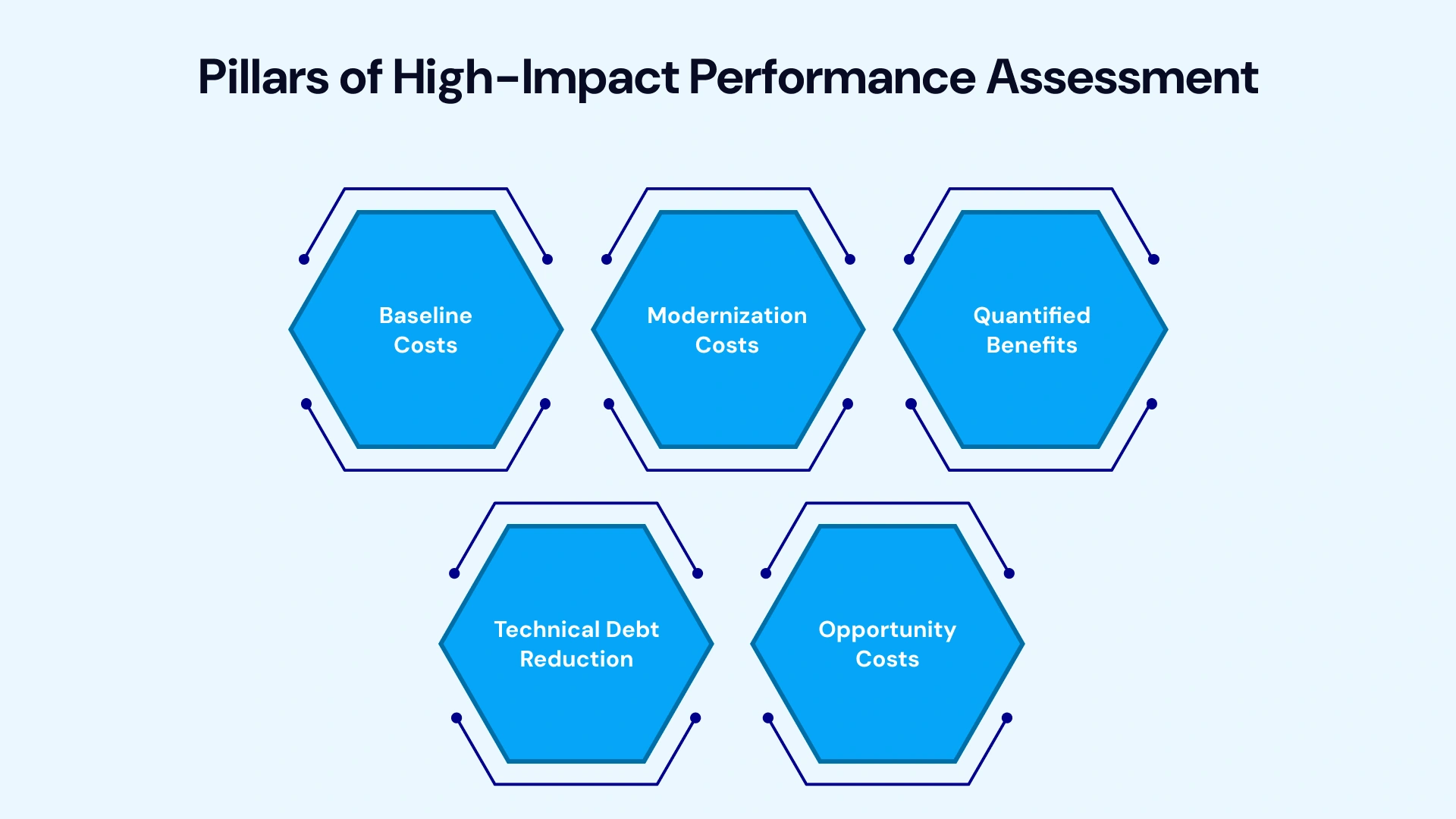
1. Baseline Costs: The total annual expenditure of your current legacy systems, including yearly legacy software cost, infrastructure and hosting, specialized licensing, and the FTE (Full-Time Equivalent) costs of employees dedicated solely to "keeping the lights on."
2. Modernization Costs: The one-time and recurring costs of the project, including initial development, data migration, testing, training, and the subscription fees for new cloud-native platforms.
3. Quantified Benefits: The measurable financial upsides post-migration, including legacy system modernization cost savings from reduced server and power consumption, risk mitigation from avoided security breaches, and revenue gains from faster feature time-to-market.
4. Technical Debt Reduction: This assesses the financial and operational burden of unaddressed technical issues in the legacy system. It quantifies savings from reduced code complexity, fewer production defects, and a significant decrease in time spent on maintenance and bug fixes relative to new feature development.
5. Opportunity Costs: The potential revenue or efficiency gains lost annually due to the current legacy system's functional limitations. This is a key metric in assessing the cost of inaction in legacy systems.
By synthesizing this data, the tool is a must-have for decision-makers evaluating legacy modernization ROI calculator scenarios and accurately forecasting payback periods. The result is a transparent and defensible financial model.
Key Features of an Effective Legacy App Modernization ROI Calculator
For an investment to be truly strategic, the ROI tool must be intelligent and flexible. A robust legacy app modernization ROI calculator should be far more than a simple spreadsheet—it must be an intelligent, adaptable tool aligned with enterprise-level strategic goals.
Below are the critical features that define a best-in-class ROI tool for modernization projects:
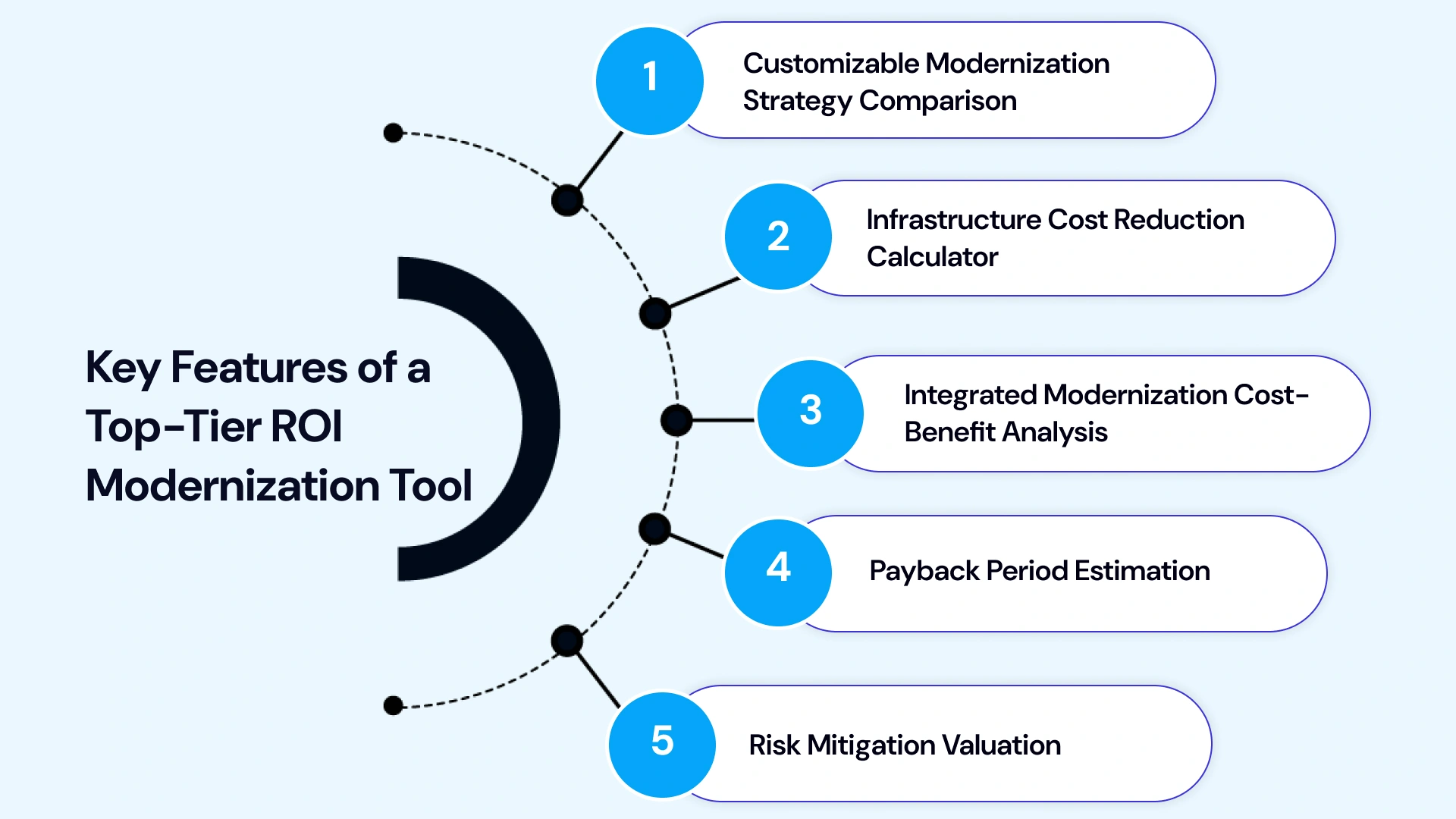
- Customizable Modernization Strategy Comparison: The tool should allow for scenario modeling based on the chosen modernization approach. This includes comparing the costs and benefits of:
- Refactoring: (Re-architecting the code to a modern framework).
- Replatforming: (Moving the application to a new runtime environment like the Cloud).
- Rehosting: (Simple "lift and shift" to a new infrastructure).
- Infrastructure Cost Reduction Calculator: This feature is essential for quantifying the savings achieved by moving from on-premises, capital expenditure (CapEx)- heavy infrastructure to a flexible, operating expenditure (OpEx) cloud migration model. It benchmarks the pre-modernization TCO (Total Cost of Ownership) against post-migration cloud expenditures.
- Integrated Modernization Cost-Benefit Analysis: Beyond comparing total costs, the tool must isolate and measure the financial impact of specific project components, such as how API enablement reduces integration time or how automated testing reduces post-deployment bugs.
- Payback Period Estimation: This is a crucial output for the CFO. The calculator must automatically determine the number of months or years until cumulative financial benefits exceed total modernization costs, providing a clear timeline for achieving positive cash flow.
- Risk Mitigation Valuation: A sophisticated calculator accounts for the value of avoided costs. By quantifying the potential financial impact of a security breach, system downtime, or regulatory fine, the calculator can assign a tangible dollar value to the reduction of technical risk achieved by modernizing legacy systems.
These features collectively empower a legacy software modernization company or in-house team to build an airtight business case for application modernization, justifying the investment with precise, data-driven projections.
The ROI Formula for Modernization Projects: Quantifying the Value
While a dedicated legacy modernization ROI calculator automates the complexity, it is built on a simple, foundational equation. For decision-makers, understanding the core modernization project ROI formula is key to appreciating the inputs and validating the outputs.
The fundamental formula for calculating the Return on Investment is:
| ROI = (Net Benefit from Modernization – Modernization Cost) / Modernization Cost × 100 |
Where the components are broken down as follows:
- Net Benefit from Modernization ($): The sum of all measurable, positive financial impacts over a defined period (typically 3–5 years).
| Net Benefit = Cost Savings (Maintenance, Infrastructure, Licensing) + Revenue Gains (Faster Time-to-Market, New Product Capability) + Productivity Improvements (Reduced Downtime, Automated Tasks) |
- Modernization Cost ($): This includes all expenses incurred to execute the project.
| Modernization Cost = Development + Implementation + Training + Initial Cloud Subscriptions/Infrastructure |
Example: A Clear-Cut Case for Investment
Consider a scenario where an outdated system is causing major financial drag:
- Annual Legacy Cost Savings (Net Benefit): $750,000 (from lower maintenance, reduced downtime, and better resource utilization).
- Total Modernization Cost: $500,000 (to refactor the application and migrate it to the cloud).
Using the formula:
- Net Profit- $250,000
- Cost- $500,000
- ROI = 50%
An ROI of 50% means the net profit equals 50% of the initial investment. In this example, the entire investment is recovered within 0.67 years (approximately 8 months), showcasing a clear, rapid payback period for modernization. The financial argument for this investment is undeniable.
How to Use a Legacy Software Modernization ROI Calculator
A structured approach ensures that the output from your legacy software modernization ROI calculator is accurate, actionable, and defensible in the boardroom. CIOs can use this process to perform a thorough modernization cost-benefit analysis before committing substantial resources.
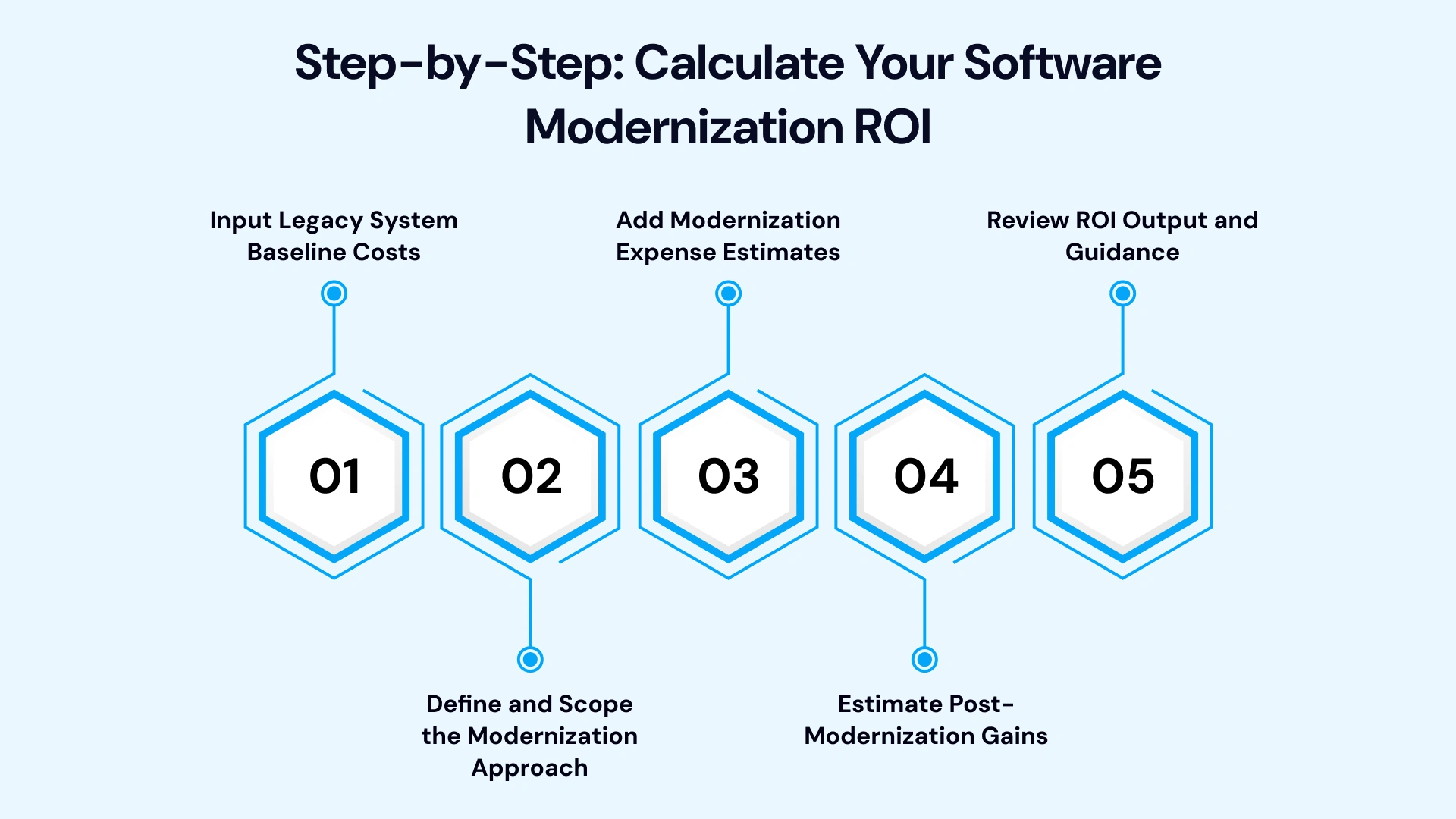
Step 1: Input Legacy System Baseline Costs
The first and most crucial step is establishing the current financial pain point. You must meticulously document all current costs associated with the legacy system:
- Annual Maintenance & Support Contracts: Specialized vendor lock-in fees and support renewals.
- Licensing Fees: Outdated, often per-core or per-CPU licenses that do not scale efficiently.
- Personnel Costs (Maintenance): The percentage of IT staff time (salaries and overhead) dedicated to legacy upkeep, bug fixes, and manual patches—not innovation.
- Downtime Cost: Calculate the average hourly cost of system outage, multiplied by the average number of hours lost per year. This quantifies the risk of overcoming the lack of support for legacy systems.
Step 2: Define and Scope the Modernization Approach
Input your proposed modernization strategy into the calculator. This allows the tool to pull relevant cost models:
- Strategy: Select refactoring, replatforming, or rehosting.
- Target State: Specify the new environment (e.g., AWS EKS, Azure App Service, Google Cloud Platform).
Step 3: Add Modernization Expense Estimates
Input all anticipated one-time and recurring modernization costs. Be conservative in your estimates:
- Migration and Re-engineering: The cost of the legacy software modernization company or in-house team performing the work.
- New Infrastructure/Cloud Spend: Estimated subscription costs, data storage, and network egress fees for the first 3–5 years.
- Training: Costs for upskilling staff on new technology stacks, such as DevOps, CI/CD pipelines, and cloud-native services.
Step 4: Estimate Post-Modernization Gains (The Benefit Inputs)
This is where the financial value of agility and performance is realized. Input quantifiable gains over the projected ROI period:
- Cost Savings: Anticipated legacy system modernization cost savings in licensing, power, and support.
- Time-to-Market: Expected reduction in the time it takes to deploy a new feature (e.g., from 4 weeks to 2 days), which translates to potential revenue uplift.
- Risk Mitigation Value: A calculated dollar value assigned to avoided security breaches and compliance fines.
- Productivity Gains: The estimated increase in developer efficiency (e.g., 25% increase in velocity) and the corresponding value of freeing up staff from maintenance tasks.
Step 5: Review ROI Output and Guidance
The IT modernization ROI calculator will generate the key metrics:
- Total ROI %
- Payback Period (in months)
- Net Present Value (NPV)
Use the output to refine the scope, select the optimal modernization path through a strategic comparison, and secure the necessary budget approvals.
The Business Case for Application Modernization
The most successful legacy software modernization company engagements understand that the business case for application modernization is not about technology—it's about measurable business agility gains and competitive advantage.
The actual value of modernization is measured by its impact on the organization's ability to generate revenue and reduce operational friction. Modernization is a direct contributor to:
- Accelerated Revenue Growth: By supporting faster product launches and new digital services, modernized applications increase agility and directly contribute to competitive advantage.
- Enhanced Customer Experience (CX): Faster, more reliable, and feature-rich applications—often enabled by a cloud migration ROI calculator—improve conversion rates and customer retention.
- Operational Efficiency: Streamlined, automated workflows and reduced manual tasks can cut IT maintenance by 30–40%, directly contributing to cost savings from legacy system modernization.
A report from Publicis Sapient and IDC emphasizes that a clear cost-benefit analysis of cloud modernization is often sufficient to secure C-suite support when the ROI of legacy modernization is clearly demonstrated and aligned with enterprise revenue goals. This is why tools like the ROI calculator for digital transformation are indispensable strategic assets.
Estimating Modernization ROI: Core Metrics That Matter
To conduct an accurate legacy system ROI analysis, finance and IT leadership must collaborate to consider the full spectrum of benefits, both tangible and intangible. A robust ROI framework for modernization initiatives encompasses more than just cost reduction.
Tangible ROI Metrics
These are the benefits that can be directly accounted for on the balance sheet:
- Reduced Legacy System Maintenance Costs: Lower spending on specialized developers, expensive licenses, and support for outdated hardware.
- Infrastructure Scaling Efficiency: Moving to a cloud-native, pay-as-you-go model delivers significant financial benefits from cloud migration.
- Decreased Unplanned Downtime: A direct, quantifiable saving measured by the cost per hour of outage.
- Improved Resource Utilization: Lower server counts, lower cooling and power consumption, as shown by an infrastructure cost reduction calculator.
Intangible ROI Metrics
These are strategic benefits that lead to long-term value, often feeding into future revenue growth:
- Employee Productivity & Retention: Modern tools and platforms reduce friction, increasing job satisfaction and boosting productivity gains after modernization by 25–40%.
- Faster Innovation Cycles: Modern microservices and API-driven architectures reduce feature deployment time, improving business agility gains.
- Customer Loyalty & Retention: Reliable, fast services improve Net Promoter Scores (NPS) and Customer Lifetime Value (CLV).
- Future-proofing IT Systems: The long-term value of eliminating legacy system technical debt and ensuring the platform is ready for future technologies like AI/ML.
By integrating these insights, you ensure that the estimating modernization ROI process is holistic and aligned with long-term business strategy.
Case Study Example: Measuring ROI in Action
A tangible example clearly demonstrates how a Legacy Modernization ROI Calculator translates into real-world financial performance.
A North American logistics company, relying on a 20-year-old monolithic system for its core scheduling and inventory, was struggling with high maintenance costs and 99.5% uptime (resulting in significant annual downtime).
The company invested $1.2 million in a modernization initiative to replatform the system to a cloud-based microservices architecture, leveraging an IT modernization ROI calculator to validate the project.
Results Achieved Within 24 Months:
- Application Downtime Reduced: By 82%, saving an estimated $450,000 annually in lost revenue and service credits.
- Maintenance Costs Dropped: By 45%, achieved through eliminating expensive mainframe contracts and reducing dedicated support staff.
- Developer Productivity Rose: By 60%, measured by an increase in features deployed per sprint.
- Modernization ROI Calculator Final Output: The results showed a compelling 162% ROI over 24 months, with the modernization payback period achieved in just 11 months.
This successful transformation didn't just improve performance; it also increased business agility and demonstrated that modernizing legacy systems directly translates into measurable financial performance and reduced technical debt.
Cost of Inaction in Legacy Systems: The Financial Risk of Waiting
One of the most persuasive arguments a legacy software modernization company can make—and one that is vital to the ROI of legacy modernization—is quantifying the financial risk of not modernizing. The cost of inaction in legacy systems often exceeds the total cost of modernization, making it an inevitable strategic necessity.
Organizations that defer modernizing legacy systems face mounting and often unpredictable risks:
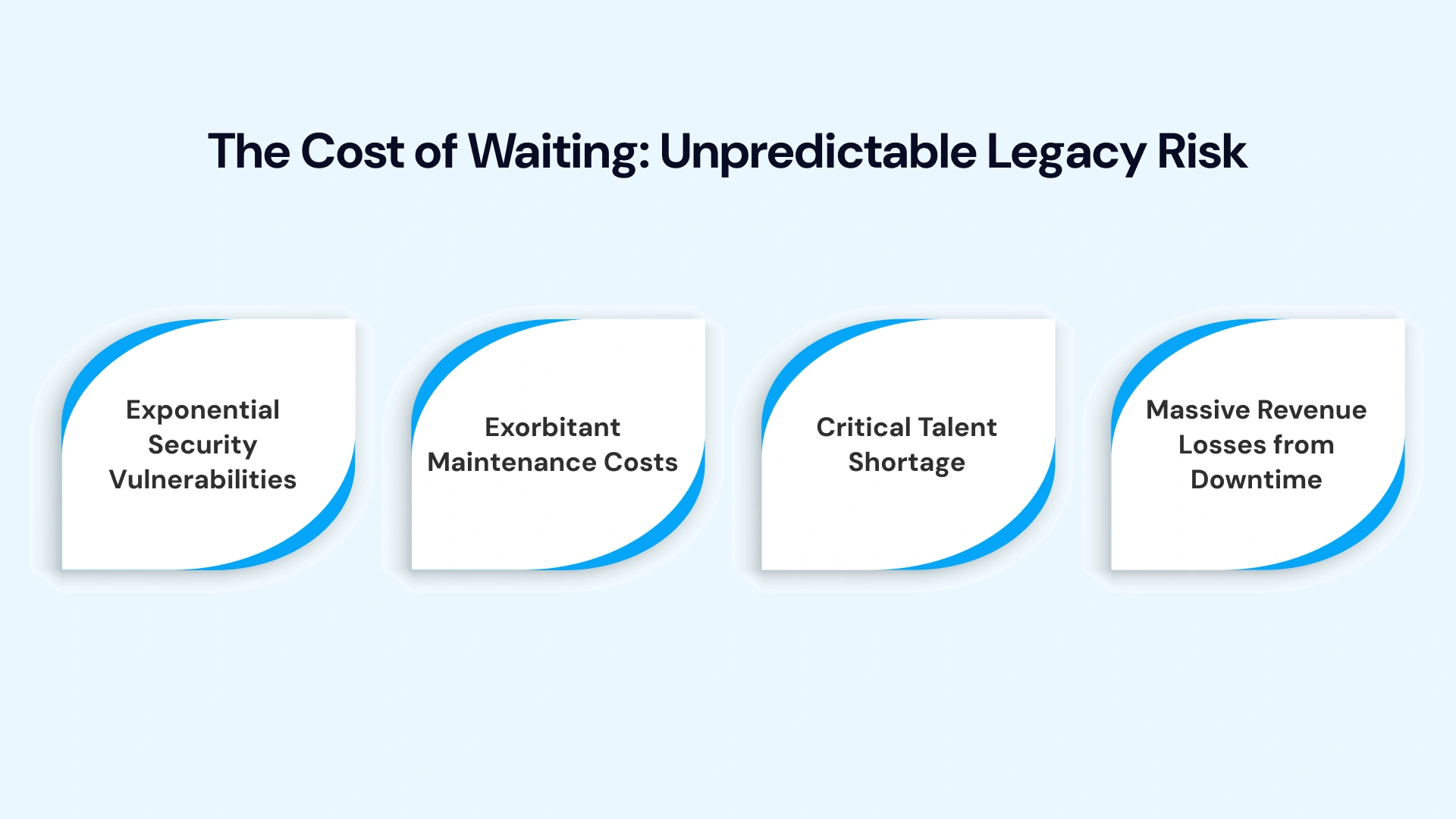
- Exponential Security Vulnerabilities: Outdated operating systems and unpatched applications are prime targets for cyberattacks. A significant breach can cost millions in recovery, fines, and reputation damage, vastly exceeding the initial cost of modernization.
- Exorbitant Maintenance Costs: Legacy system maintenance costs consume an average of 80% of an IT budget, a percentage that only grows as technology ages. This leaves a minimal budget for innovation and strategic growth projects.
- Critical Talent Shortage: The pool of skilled professionals for legacy programming languages (such as COBOL and Ada) is shrinking rapidly. This leads to high attrition risk and skyrocketing salaries for the few remaining experts, making it difficult to overcome the lack of support for legacy systems.
- Massive Revenue Losses from Downtime: System outages in large enterprises can cost $300,000–$700,000 per hour, a risk that increases as monolithic applications become more fragile.
A 2023 US Government Accountability Office report noted that some of the government’s oldest legacy systems alone incur annual maintenance costs of over $337 million. When viewed through this lens, the legacy modernization ROI calculator becomes a risk calculator, demonstrating that modernization is fundamentally a strategy for financial stability and risk avoidance.
Cloud Migration ROI Calculator: Amplifying Benefits
Cloud migration is often the cornerstone of any modernization project. A specific cloud migration ROI calculator is a powerful subset of the overall modernization tool, focusing specifically on the financial gains of infrastructure transformation.
Migration to a hyper-scale cloud environment (like AWS, Azure, or GCP) delivers benefits that significantly accelerate the overall ROI of legacy modernization:
- 40–60% Reduction in Infrastructure Costs: Achieved by eliminating data centers, server depreciation, power, and cooling costs. This provides significant benefits in reducing infrastructure costs.
- Improved Scalability and Elasticity: The ability to scale resources up and down instantly via a pay-as-you-go model minimizes wasted compute cycles and capital expenditure.
- Enhanced Compliance and Uptime: Modern cloud environments offer built-in security and resilience features that drastically improve risk posture and reliability.
- Faster Innovation Cycles: Integrated DevOps toolchains and microservices architecture enable rapid, low-risk deployment.
When a cloud migration ROI calculator is seamlessly integrated into a larger digital transformation ROI calculator, it quantifies exactly how optimizing infrastructure resources enhances long-term profitability, making the total modernization cost-benefit analysis overwhelmingly positive.
ROI Comparison: Refactoring vs. Replatforming vs. Rehosting
Choosing the right approach is a strategic decision that heavily influences both the modernization costs and the eventual ROI of legacy modernization. A good legacy modernization ROI calculator allows for a quick modernization strategy comparison to model these options:
| Modernization Strategy | Description | Typical ROI Range | Key Benefit | Payback Period |
| Refactoring | Rewriting the legacy code for a modern, often microservices-based, architecture. | 25–45% | Eliminates technical debt and improves agility. | 2–3 years |
| Replatforming | Moving the application to a new runtime platform (e.g., cloud containerization) with minimal code change. | 20–35% | Significant cost savings and platform agility. | 2–2.5 years |
| Rehosting | Simple "Lift and Shift" of the application to a new environment (usually the cloud) without changing the code. | 10–25% | Quick migration, minimal disruption, and initial cost reduction. | 1–1.5 years |
| Replacement | Sunsetting the legacy system and implementing a COTS (Commercial Off-The-Shelf) or SaaS solution. | Variable | Lowers maintenance; ROI depends heavily on licensing costs. | 1–3 years |
These comparisons empower IT leaders and legacy app modernization consulting partners to align their financial goals with the organization's technical feasibility and risk tolerance. The optimal path is always the one that delivers the maximum legacy modernization ROI calculator outcome for the least business disruption.
IT Cost Optimization Tools for Modernization Projects
Achieving a high ROI of legacy modernization requires accurate planning and precise cost management. IT cost optimization tools are essential for managing the financial viability and long-term performance of modernization projects.
These specialized tools go beyond the basic ROI calculator to offer:
- Software Improvement Group’s Sigrid® ROI Calculator: Provides benchmarking of the quality of the legacy code to accurately assess the cost and effort required for refactoring or replatforming.
- Aspire Systems Microservices ROI Tool: Focuses on the returns from modular architecture, helping organizations calculate the actual value of productivity gains after modernization.
- NASSCOM Modernization ROI Framework: Offers a comprehensive digital transformation measurement framework to calculate full ROI, including intangible benefits.
By leveraging these automation tools, organizations ensure that their investments in modernizing legacy systems are not only financially sound but also strategically aligned with long-term business growth.
ROI Metrics for Business Agility and Productivity
The most valuable metric from modernization is the sustained increase in business agility gains and employee productivity. This translates directly into a competitive advantage—the ability to react to market changes faster than competitors.
After modernization, enterprises typically measure significant improvements in operational metrics that feed directly back into the ROI of legacy modernization:
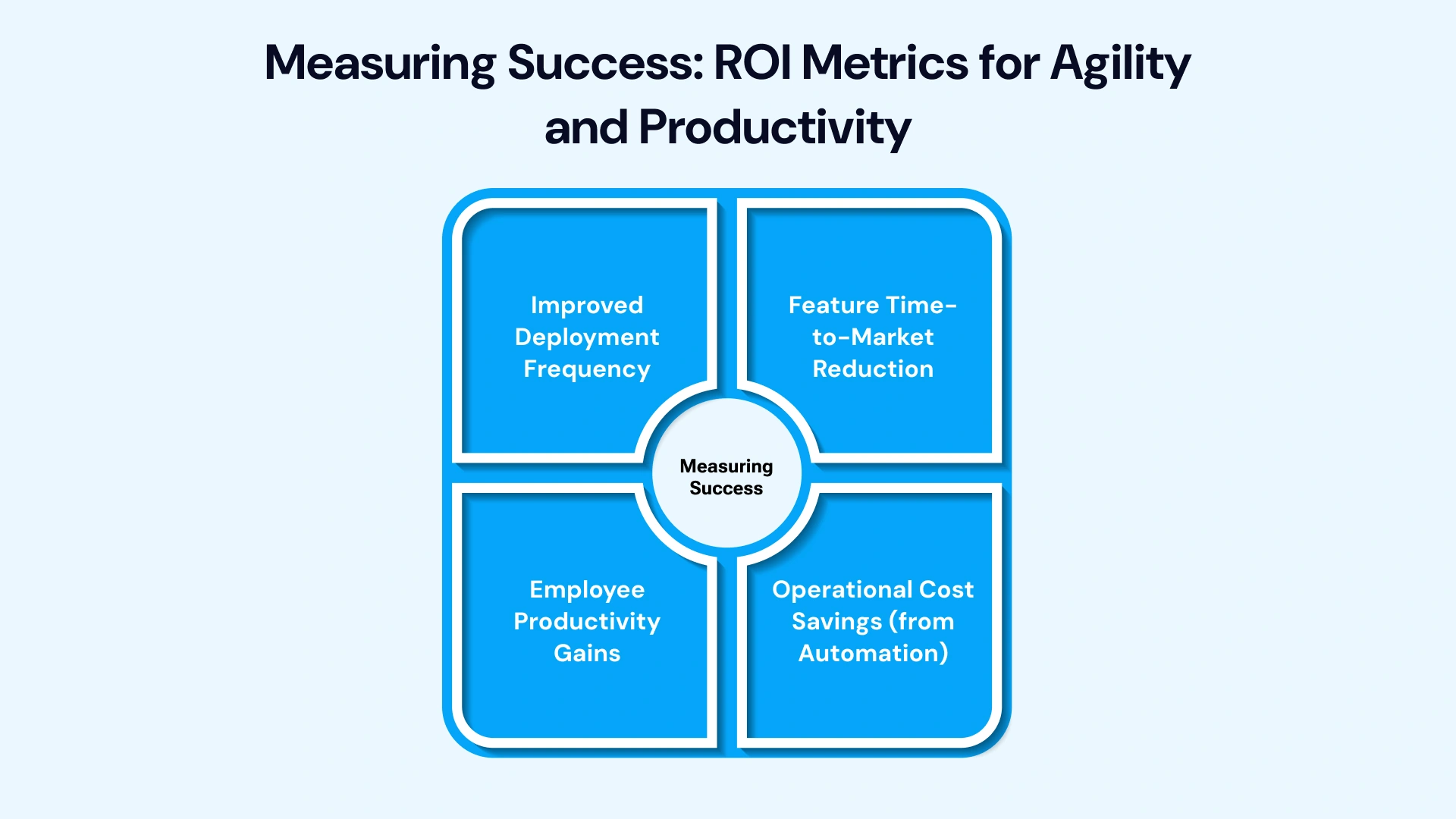
- Improved Deployment Frequency: Teams often report an 80% faster deployment rate vs. the legacy environments, enabling rapid feature delivery.
- Feature Time-to-Market Reduction: A reduction of up to 50% in the time it takes to move from concept to customer-facing feature.
- Operational Cost Savings (from Automation): A 20–30% annual reduction in costs associated with manual processes and system administration.
- Employee Productivity Gains: A 25–40% increase in measurable output post-cloud enablement, as developers focus on innovation rather than maintenance.
These productivity gains from modernizing legacy systems enhance the total ROI of legacy modernization across all segments—from finance and manufacturing to healthcare and retail —by accelerating the overall pace of business.
Measuring ROI Beyond Financial Gains
While the Legacy Modernization ROI Calculator is essential for securing capital, a successful modernization project’s impact extends far beyond the spreadsheet. The investment generates significant resilience and future-proofing value.
Modernization projects improve:
- Security Posture: Moving to modern, supported platforms eliminates the major risks associated with overcoming the lack of support for legacy systems.
- Compliance: Modern cloud services offer built-in, auditable compliance standards that simplify adherence to regulations such as HIPAA, GDPR, and SOC 2.
- Business Continuity: Microservices and cloud-native resilience patterns drastically reduce the risk of catastrophic system failure.
For instance, applications enabled with real-time analytics and hyper-automation capabilities often report a 3-year ROI exceeding 200%, driven by both cost savings and immense innovation-driven value creation. Modernizing legacy systems is, therefore, a strategic enabler of continuous innovation, not just a necessary expense.
Legacy System Modernization Cost Savings
By strategically consolidating architectures and adopting serverless or cloud-native technology, organizations realize profound and sustained legacy system modernization cost savings that make the entire investment financially viable:
- 30–50% Reduction in Operational Overhead: Achieved by moving from manual, on-premises management to automated, managed cloud services.
- Up to 70% Improvement in Scalability Efficiency: The ability to pay only for the resources consumed—and not for peak capacity infrastructure sitting idle—is a massive fiscal advantage.
- Lower Licensing Fees and Reduced Vendor Lock-in: Moving to open-source or consumption-based models eliminates reliance on expensive, specialized vendor support for legacy software.
These financial realities demonstrate why the ROI of legacy modernization is consistently positive. The recurring legacy system modernization cost savings fund new digital initiatives, strategically transforming the IT budget from a cost center into a powerful engine for business growth.
Modernizing Legacy Systems with VLink Expertise
VLink brings a proven, holistic approach to legacy system modernization, transforming outdated, costly, and rigid IT infrastructure into agile, scalable, and cloud-native platforms. Our expertise is not just in technology migration, but in strategic re-engineering that unlocks significant business value, reduces technical debt, and accelerates digital transformation.
VLink's Strategic Modernization Pillars:
- Comprehensive Assessment & Strategy: We begin with an in-depth analysis of your existing legacy codebase, architecture (e.g., COBOL, VB6, Mainframe), and business processes. This allows us to craft a customized modernization roadmap using the right "R" strategies (Rehost, Replatform, Rearchitect, Refactor, Replace, or Retain) that aligns technology to change directly with your specific business outcomes.
- Cloud-Native & Microservices Architecture: Our dedicated teams specialize in breaking down monolithic applications into modular, independent microservices and deploying them on modern cloud platforms (AWS, Azure, GCP). This ensures unprecedented scalability, resilience, and faster feature deployment.
- Risk Mitigation and Business Continuity: We utilize a phased, evolutionary modernization approach to ensure that core business operations remain uninterrupted throughout the transition. Techniques such as reverse engineering undocumented systems (as demonstrated in our successful insurance-sector case studies) recover lost knowledge and reduce risk.
- Full-Stack Technological Proficiency: VLink's experts possess deep expertise in migrating legacy systems and applications to modern stacks, including Java, .NET Core, Python, React, and modern SQL/NoSQL databases, ensuring a future-proof, maintainable, and cost-efficient final solution.
- Achieving Measurable ROI: Our focus is on tangible results, including reduced maintenance costs, improved developer productivity, accelerated time-to-market for new products, and enhanced system performance, all of which contribute to a rapid and compelling Return on Investment (ROI).
Conclusion: Harness the Power of ROI-Driven Modernization
Modernizing legacy systems goes beyond rewriting code—it’s a proactive, essential investment in operational efficiency, risk mitigation, and business agility. The true competitive edge today is the speed at which an enterprise can innovate, and legacy systems are the biggest blocker to that speed.
Using an intelligent Legacy Modernization ROI Calculator, businesses can measure what truly matters: reduced legacy software cost, higher financial returns, and improved resilience against market and technological disruption.
A well-defined ROI framework for modernization initiatives offers the financial clarity that CIOs and CFOs require to fund modernization confidently and strategically. By eliminating the high cost of inaction in legacy systems and leveraging the significant savings from modernizing them, you don't just upgrade your technology; you redefine your financial and operational future.
Is your organization ready to accurately calculate ROI for legacy modernization and identify untapped growth opportunities within your current IT portfolio? Contact us today to schedule your free modernization ROI assessment and begin your journey from legacy burden to innovation power.
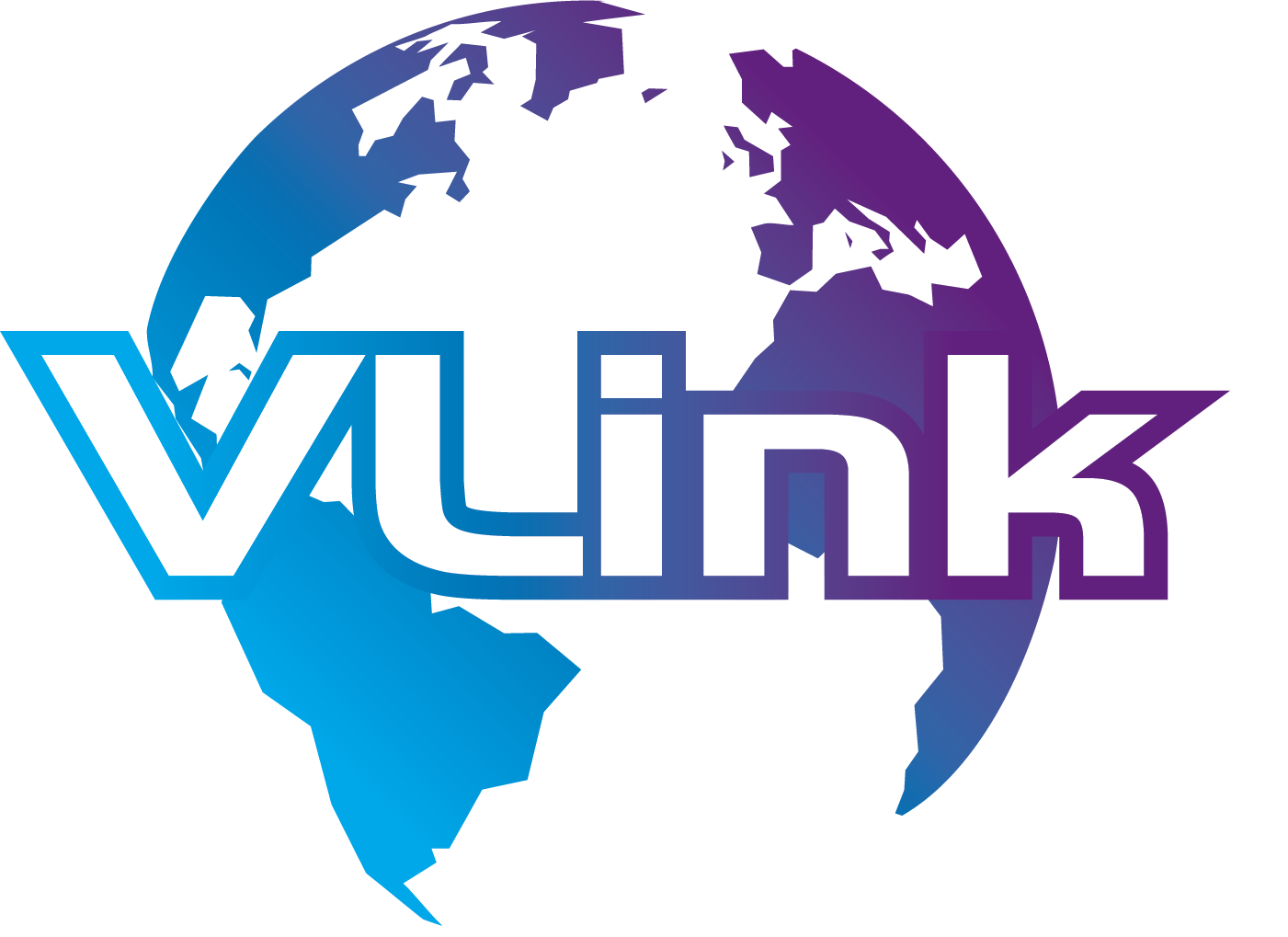









 Shivisha Patel
Shivisha Patel












